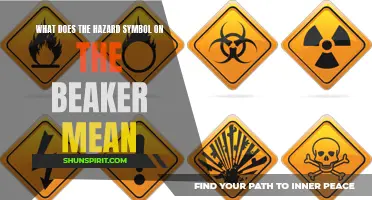
Have you ever wandered down the cleaning aisle at the supermarket and seen those mysterious diamond-shaped labels with a skull and crossbones or an exclamation mark? These symbols are called GHS symbols, and they hold important meanings about the hazards associated with the products they're attached to. In this article, we will unravel the mysteries behind GHS symbols and understand why they are crucial for our safety. So, let's dive in and uncover the hidden language of these symbols!
What You'll Learn
- What are GHS symbols and what do they represent?
- How many categories or hazard classes are there in GHS symbols?
- What are some of the common GHS symbols and their meanings?
- Why is it important for workers to understand GHS symbols and their meanings?
- How are GHS symbols and meanings used in safety data sheets?

What are GHS symbols and what do they represent?
GHS symbols, also known as hazard pictograms, are standardized icons used to represent different types of hazards in the workplace. These symbols were developed by the United Nations and are part of the Globally Harmonized System of Classification and Labelling of Chemicals (GHS). The purpose of these symbols is to provide a quick and easy way to convey important information about the hazards associated with specific chemicals.
There are a total of nine GHS symbols, each representing a different hazard category. These categories include explosive, flammable, oxidizing, gases under pressure, toxic, harmful, corrosive, irritant, and environmental hazards. Each symbol features a black pictogram on a white background, surrounded by a red diamond-shaped border. The symbols are designed to be easily recognizable and understood, even by individuals who may not be familiar with the specific language or terminology used in the workplace.
The GHS symbols provide valuable information about the potential dangers associated with different substances. For example, the explosive hazard symbol depicts a bomb, indicating that the substance is potentially explosive. The flammable hazard symbol depicts a flame, indicating that the substance is flammable or can ignite easily. The toxic hazard symbol depicts a skull and crossbones, indicating that the substance is toxic and can cause serious harm or even death.
In addition to the symbol itself, each GHS label also includes a signal word and hazard statement to further inform individuals about the specific hazards posed by the substance. The signal word is either "danger" or "warning," depending on the severity of the hazard, while the hazard statement provides more detailed information about the specific risks associated with the substance.
Employers are responsible for ensuring that GHS symbols and labels are properly displayed on all containers and packaging containing hazardous chemicals in the workplace. This helps to ensure the safety and protection of employees by providing clear and concise information about the potential hazards they may encounter while handling these substances.
In conclusion, GHS symbols are standardized icons used to represent different types of hazards in the workplace. These symbols are designed to be easily recognizable and understood, providing important information about the potential dangers associated with specific substances. By using GHS symbols and labels, employers can help protect their employees and create a safer working environment.
The Symbolic Meaning of the Red Rose: Unveiling Its Deep Significance
You may want to see also

How many categories or hazard classes are there in GHS symbols?
Globally Harmonized System of Classification and Labelling of Chemicals (GHS) is an internationally recognized system for classifying and communicating the hazards of chemicals. GHS symbols are used to visually represent different categories or hazard classes of chemicals. These symbols are designed to be easily understood across different cultures and languages.
There are a total of nine hazard classes in GHS symbols. Each class represents a specific type of hazard, allowing users to quickly identify the potential dangers associated with a particular chemical. The nine hazard classes are as follows:
- Explosives: This class includes substances and mixtures capable of causing an explosion.
- Flammable Gases: Gases that are flammable in the presence of air or oxygen fall under this class.
- Flammable Liquids: Liquids with a flash point below 60 degrees Celsius (140 degrees Fahrenheit) are considered flammable.
- Flammable Solids: Solids that are capable of causing a fire through friction, absorption of moisture, or spontaneous chemical reactions are classified as flammable solids.
- Oxidizing Gases: Gases that promote or support the combustion of other materials are classified as oxidizing gases.
- Oxidizing Liquids: Liquids capable of releasing oxygen and promoting the combustion of other materials are included in this class.
- Oxidizing Solids: Solids that are capable of releasing oxygen and promoting the combustion of other materials fall under this class.
- Toxic Substances: This class includes chemicals that can cause acute toxicity and pose a serious health hazard.
- Hazardous to the Environment: Chemicals that can have adverse effects on the environment, including aquatic life, are classified as hazardous to the environment.
Each hazard class in GHS symbols is represented by a specific symbol. These symbols are widely used on chemical labels, safety data sheets, and hazard communication systems to provide essential information about the potential risks associated with a particular chemical.
It is important for individuals working with or handling chemicals to be familiar with GHS symbols and understand their meanings. This knowledge can help prevent accidents and ensure the safe handling and storage of hazardous substances. GHS symbols provide a universal language for communicating hazards, making it easier to identify and mitigate risks in various working environments.
Understanding the Symbolic Meaning of Akan Symbols
You may want to see also

What are some of the common GHS symbols and their meanings?
GHS, which stands for the Globally Harmonized System of Classification and Labelling of Chemicals, is an internationally recognized system that is used to classify and communicate the hazards of chemicals. GHS symbols, also known as pictograms, are used to visually represent the different types of hazards associated with a particular chemical.
There are several common GHS symbols that you may come across in various settings, including workplaces, laboratories, and consumer products. Each symbol has a specific meaning that indicates the type of hazard associated with the chemical. Here are some of the most common GHS symbols and their meanings:
- Flame: The flame symbol is used to indicate that the chemical is flammable and could ignite easily when exposed to heat, sparks, or flames. This symbol serves as a warning to handle the chemical with caution and to keep it away from potential ignition sources.
- Exclamation mark: The exclamation mark symbol is used to indicate that the chemical may cause harm to human health or the environment. It often represents a less severe hazard compared to other symbols, but it still warrants attention and careful handling.
- Skull and crossbones: The skull and crossbones symbol is used to indicate that the chemical is highly toxic and can cause severe health effects or even death if ingested, inhaled, or absorbed through the skin. This symbol is typically used for substances that pose an acute toxicity hazard.
- Corrosion: The corrosion symbol is used to indicate that the chemical can cause damage to metals, skin, and other materials upon contact. This symbol serves as a warning to take precautions to prevent contact with the corrosive substance and to use appropriate protective equipment.
- Gas cylinder: The gas cylinder symbol is used to indicate that the chemical is stored under pressure in a gas cylinder. This symbol serves as a reminder to handle the cylinder with caution and to be aware of potential risks associated with pressurized gases.
- Environment: The environment symbol is used to indicate that the chemical has the potential to cause harm to aquatic life, soil, or other elements of the environment. This symbol serves as a reminder to handle and dispose of the chemical properly to prevent environmental contamination.
These are just a few examples of the common GHS symbols and their meanings. It is important to familiarize yourself with these symbols and their corresponding hazards to ensure safe handling and use of chemicals in various settings. Remember to always read and understand the labels and safety data sheets provided with chemicals to identify any hazards and take appropriate precautions.
The Symbolism of February: Exploring the Meaning Behind the Month
You may want to see also

Why is it important for workers to understand GHS symbols and their meanings?
Understanding GHS symbols and their meanings is crucial for workers across various industries. The Globally Harmonized System of Classification and Labelling of Chemicals (GHS) was developed to ensure consistent communication and safe handling of hazardous substances. GHS symbols, also known as pictograms, provide visual representations of the potential hazards associated with specific chemicals. Here are a few reasons why it is important for workers to understand GHS symbols and their meanings:
- Personal Safety: GHS symbols serve as a quick and easy way for workers to identify potential hazards and take appropriate safety measures. By understanding the meaning behind each symbol, workers can quickly assess the risks associated with handling certain chemicals, such as flammability, toxicity, or corrosiveness. This knowledge allows them to use appropriate Personal Protective Equipment (PPE) and follow proper safety protocols to minimize exposure and prevent accidents.
- Emergency Response: GHS symbols are not only useful during routine operations but also in emergency situations. In case of a spill, leak, or any other hazardous incidents, emergency responders need to quickly identify the nature of the chemicals involved to determine the appropriate course of action. By understanding GHS symbols, workers can relay important information to emergency personnel, facilitating a more effective and timely response to mitigate any potential risks.
- Global Standardization: The purpose of GHS is to harmonize chemical classifications and hazard communication globally. This standardization ensures that workers around the world can understand and interpret GHS symbols consistently, regardless of their language or geographical location. It enables workers to effectively communicate hazards and safety information related to chemicals, especially in multinational workplaces or during international trade of chemicals.
- Chemical Handling and Storage: GHS symbols provide essential information regarding the proper handling, storage, and disposal of chemicals. Workers who are aware of these symbols can identify the necessary precautions to take when working with or around hazardous substances. This includes following specific storage requirements, adhering to proper handling techniques, and using appropriate equipment to prevent accidents or chemical interactions that could lead to hazardous situations.
- Compliance with Regulations: Many countries and regions have adopted GHS as part of their chemical regulations. Employers and workers have a legal obligation to comply with these regulations, ensuring the safe handling and use of chemicals in the workplace. Understanding GHS symbols and their meanings is vital for maintaining compliance and avoiding penalties or legal consequences.
In conclusion, it is crucial for workers to understand GHS symbols and their meanings to ensure personal safety, facilitate emergency response, adhere to global standards, handle and store chemicals properly, and comply with regulations. This knowledge empowers workers to make informed decisions and take necessary precautions when working with hazardous substances, reducing the risk of accidents, injuries, and adverse health effects.
The Symbolic Meaning Behind the Blue Cross
You may want to see also

How are GHS symbols and meanings used in safety data sheets?
Safety data sheets (SDS) are documents that provide important information about hazardous substances and chemicals used in the workplace. They are essential for ensuring the safety of workers and the proper handling and storage of hazardous materials. One important aspect of SDS is the use of Globally Harmonized System (GHS) symbols and meanings.
GHS symbols are standardized pictograms that are used to convey important information about the hazards of a substance. These symbols are universal and are recognized and understood by workers around the world. The use of these symbols on SDS provides a clear and concise way to communicate the potential hazards of a substance.
There are several different GHS symbols that represent different types of hazards. These include symbols for physical hazards, health hazards, and environmental hazards. Each symbol has a specific meaning and is used to indicate the specific hazard associated with a substance.
For example, the flame symbol is used to indicate that a substance is flammable or can ignite easily. This symbol warns workers about the potential risk of fire and helps them take appropriate precautions to prevent accidents. Similarly, the skull and crossbones symbol is used to indicate that a substance is toxic and can cause serious health problems if it is not handled properly.
GHS symbols are accompanied by clear and concise descriptions of the hazards associated with a substance. These descriptions provide additional information about the potential risks and help workers understand the specific precautions that need to be taken. For example, a description may include information about the specific health effects that a substance can have, such as eye irritation, respiratory problems, or skin sensitization.
In addition to the symbols and descriptions, SDS also include important information about the safe handling and storage of hazardous substances. This information includes details about the proper storage conditions, recommended personal protective equipment, and emergency procedures in case of accidents or spills. By providing this information, SDS help workers understand how to safely handle hazardous substances and minimize the risk of accidents and injuries.
It is important for employers and workers to be familiar with GHS symbols and meanings to ensure the safe handling and use of hazardous substances. Employers should provide training and education to their employees about the meaning and significance of GHS symbols and how to interpret them. This will help workers recognize and understand the potential hazards associated with a substance and take appropriate precautions to protect themselves and others.
In conclusion, GHS symbols and meanings are an essential part of safety data sheets. They provide a universal and standardized way to communicate the hazards of a substance and help workers understand and mitigate the risks associated with hazardous materials. By using these symbols and meanings, employers can ensure the safety of their workers and create a safe working environment.
Understanding Chevrolet Dashboard Symbols and Meanings: A Guide for Drivers
You may want to see also
Frequently asked questions
The purpose of GHS (Globally Harmonized System) symbols is to provide clear and consistent communication of information about hazardous chemicals. These symbols are used to convey the potential hazards of a chemical, allowing workers and consumers to make informed decisions and take appropriate precautions.
There are nine GHS symbols, also known as GHS pictograms, that represent different hazard categories. These symbols include the flame, exclamation mark, health hazard, corrosion, skull and crossbones, gas cylinder, explosion, flame over circle, and environmental hazard.
Each GHS symbol has a specific meaning. The flame symbol represents flammable substances, the exclamation mark symbol indicates chemicals that may cause health hazards, the health hazard symbol signifies substances that can cause serious health effects, the corrosion symbol represents substances that can corrode or dissolve materials, the skull and crossbones symbol is used for substances that are acutely toxic or fatal, the gas cylinder symbol signifies gases under pressure, the explosion symbol represents substances and mixtures that can explode under certain conditions, the flame over circle symbol indicates chemicals that are oxidizing agents, and the environmental hazard symbol is used for substances that can have adverse effects on the environment.
Yes, GHS symbols are internationally recognized. The United Nations developed the GHS to create a standardized system for classifying and labeling hazardous chemicals, and it has been adopted by many countries around the world. This allows for consistent communication of chemical hazards across different countries and industries.
GHS symbols should be displayed prominently on chemical containers and packaging. They should be easily visible and legible, and should not be covered or obscured by other labels or markings. Additionally, the symbols should be accompanied by the relevant hazard and precautionary statements, which provide additional information about the specific hazards and necessary precautions associated with a chemical.







